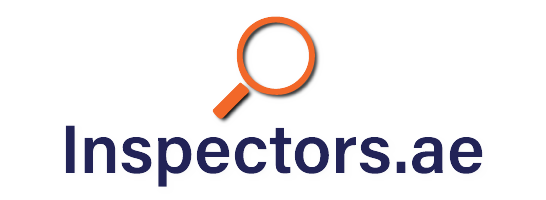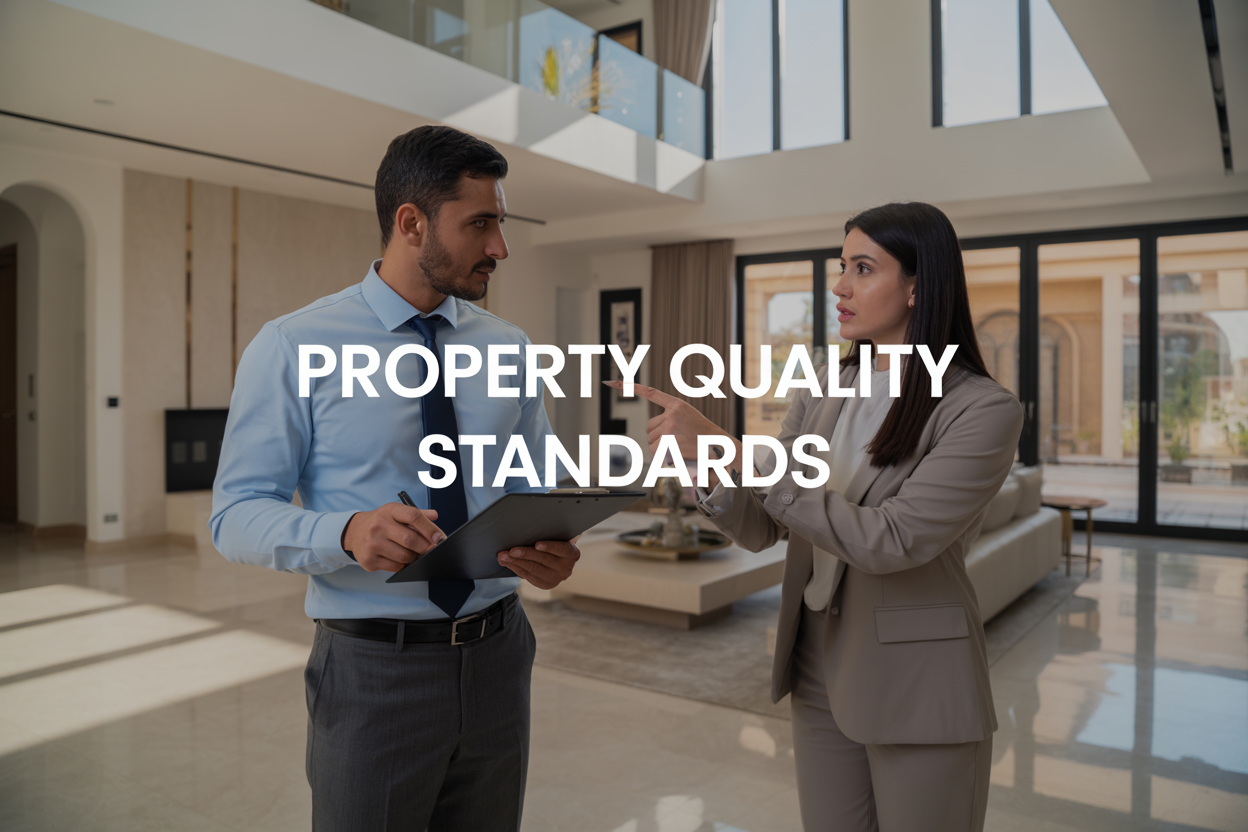
Buying a home in the UAE is a major investment, and you want to make sure you’re getting exactly what you pay for. A thorough property quality check protects you from costly surprises and ensures your UAE home meets all safety and building standards.
This guide is for home buyers, property investors, and current homeowners who want to understand what makes a quality property inspection and how to spot potential issues before they become expensive problems.
We’ll walk you through the essential pre-purchase inspections that can save you thousands of dirhams and explain UAE building code compliance standards that every homeowner should know. You’ll also discover the professional assessment tools that deliver the most accurate results, so you can buy or maintain your home with complete confidence.
Essential Pre-Purchase Property Inspections That Protect Your Investment
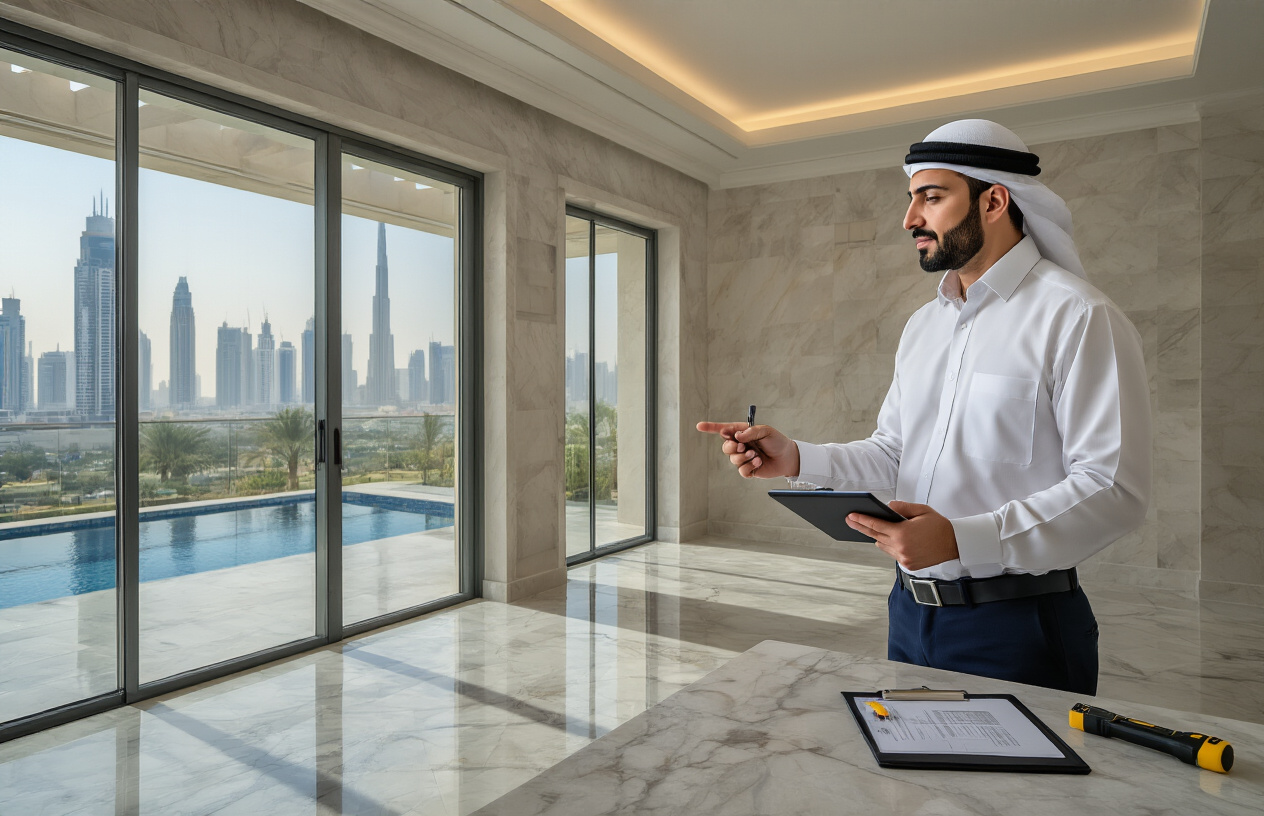
Structural Integrity Assessments That Prevent Costly Surprises
When you’re looking at properties in the UAE, the building might look perfect on the surface, but what’s happening underneath can make or break your investment. Structural assessments dig deep into the bones of your potential home, examining everything from the foundation to the roof framework. These evaluations save you from walking into financial disasters that could cost hundreds of thousands of dirhams down the road.
Professional structural engineers use specialized equipment to detect problems that regular property inspection might miss. They check for foundation settlement, which is particularly important in UAE’s sandy soil conditions. Desert environments create unique challenges for building foundations, and even minor settling can lead to significant structural issues over time. Engineers examine concrete quality, looking for signs of deterioration, cracking, or improper mixing ratios that compromise the building’s integrity.
Load-bearing walls receive special attention during these assessments. Many UAE properties undergo renovations where previous owners might have modified structural elements without proper engineering approval. Removing or altering load-bearing components creates dangerous situations that aren’t always immediately visible. The assessment includes checking beam deflection, column alignment, and joint connections throughout the structure.
Reinforcement steel inspection reveals another layer of potential problems. UAE’s coastal humidity and occasional sandstorms can accelerate corrosion in improperly protected rebar. Advanced techniques like ground-penetrating radar help identify rebar placement, density, and condition without damaging the concrete. This technology proves invaluable for detecting construction shortcuts that builders sometimes take.
Water infiltration poses serious structural threats in UAE properties. Even though the region receives limited rainfall, when storms do occur, buildings face intense water exposure. Structural assessments examine waterproofing systems, drainage effectiveness, and signs of moisture penetration that could weaken concrete or cause steel corrosion. Balconies, terraces, and roof areas get particular scrutiny since these elements face the harshest weather conditions.
Building movement monitoring has become increasingly sophisticated. Engineers install specialized sensors that measure micro-movements over time, detecting settling patterns or structural shifts that might indicate foundation problems or soil instability. These measurements provide concrete data about building stability rather than relying solely on visual inspections.
Electrical System Evaluations Ensuring Safety Compliance
UAE electrical systems must meet stringent safety standards, but not all properties actually comply with these regulations. Professional electrical evaluations protect you from fire hazards, electrocution risks, and expensive code violations that could surface after purchase. These comprehensive home inspection processes examine every component of the electrical infrastructure, from the main service panel to individual outlets.
Circuit breaker panels tell the story of your property’s electrical health. Experienced electricians check for proper breaker sizing, correct wire gauges, and appropriate circuit loads. Overloaded circuits represent serious fire risks, especially common in older UAE properties where electrical demands have increased beyond original design specifications. Panel inspections reveal whether previous electrical work followed proper installation procedures or if dangerous shortcuts were taken.
Grounding systems receive critical attention during electrical evaluations. UAE building codes require proper grounding for safety, but many properties have inadequate or improperly installed grounding systems. Inspectors test ground fault circuit interrupters (GFCIs) in bathrooms, kitchens, and outdoor areas where water contact creates electrocution hazards. These safety devices must function correctly to protect inhabitants from electrical shocks.
Wire condition assessment involves checking insulation quality, proper routing, and connection integrity throughout the property. UAE’s extreme heat can accelerate wire insulation deterioration, creating fire hazards or electrical failures. Inspectors look for outdated wiring materials, improper junction boxes, and amateur electrical modifications that violate safety codes. Aluminum wiring, common in some older UAE properties, requires special attention due to expansion and contraction issues that can cause connection failures.
Electrical capacity analysis determines whether the system can handle modern electrical demands. Today’s UAE homes require significant power for air conditioning, kitchen appliances, home automation systems, and electric vehicle charging. Inspectors calculate total electrical loads and compare them against system capacity to identify potential overload situations. Inadequate electrical capacity means expensive upgrades after purchase.
Smart home integration has become standard in UAE properties, but these systems require proper electrical infrastructure. Evaluations check whether existing wiring can support home automation, security systems, and high-speed internet requirements. Inadequate infrastructure means costly retrofitting to achieve desired technological capabilities.
Emergency electrical systems get special consideration in UAE properties. Backup power systems, emergency lighting, and fire safety electrical components must function properly during power outages or emergencies. Inspectors test these systems to verify they meet safety requirements and operate correctly when needed.
Plumbing Inspections That Identify Hidden Water Damage Risks
Water damage can destroy UAE properties quickly and expensively, making thorough plumbing inspections absolutely essential before purchase. These property inspection procedures uncover hidden leaks, pipe deterioration, and system inadequacies that could cost tens of thousands of dirhams in repairs. Professional plumbers use advanced diagnostic tools to examine every aspect of the water delivery and waste removal systems.
Pipe material assessment reveals potential problems that might not surface for years after purchase. Many UAE properties built during rapid construction periods used lower-quality materials or improper installation techniques. Inspectors examine pipe joints, fittings, and connections for signs of corrosion, scaling, or deterioration. Galvanized steel pipes, common in older properties, have limited lifespans and require replacement before catastrophic failures occur.
Water pressure testing throughout the system identifies restrictions, blockages, or capacity issues that affect daily living comfort. UAE’s municipal water systems sometimes provide inconsistent pressure, and internal plumbing problems can compound these issues. Inspectors measure pressure at multiple locations, identifying whether problems stem from municipal supply issues or internal system deficiencies.
Leak detection technology has revolutionized plumbing inspections. Electronic leak detection equipment can identify moisture behind walls, under floors, or in ceiling areas before visible damage appears. These hidden leaks cause extensive structural damage, mold growth, and expensive repair bills. Thermal imaging cameras reveal temperature differences that indicate water infiltration or pipe problems not visible to naked eye examination.
Drainage system evaluation checks waste removal efficiency and identifies potential backup risks. UAE properties sometimes experience drainage problems during heavy rainfall periods, and inadequate drainage can cause significant property damage. Inspectors test drain flow rates, examine trap seals, and check vent system functionality to ensure proper waste removal operation.
Hot water system assessment examines water heater condition, capacity, and safety features. UAE’s hard water conditions can cause significant scaling in water heaters, reducing efficiency and shortening equipment life. Inspectors check temperature relief valves, electrical connections, and tank condition to identify potential failure risks. Solar water heating systems, common in UAE properties, require specialized inspection procedures to verify proper operation and maintenance.
Cross-connection testing protects against contaminated water supply risks. Improper plumbing connections can allow non-potable water to enter drinking water systems, creating serious health hazards. Inspectors verify backflow prevention devices function properly and check for illegal connections that could compromise water quality.
HVAC System Checks Maximizing Comfort and Efficiency
UAE’s extreme climate makes HVAC systems absolutely critical for comfortable living, but these complex systems require thorough evaluation to ensure they’ll perform reliably and efficiently. Professional HVAC inspections examine cooling capacity, energy efficiency, air quality, and system longevity to protect your investment from expensive surprises. These property quality check procedures can reveal problems that cost thousands of dirhams in repairs or replacements.
Cooling capacity calculations determine whether existing systems can adequately cool your UAE home during peak summer temperatures. Many properties have undersized systems that struggle to maintain comfortable temperatures, leading to excessive energy consumption and equipment wear. Inspectors perform load calculations based on square footage, insulation levels, window efficiency, and local climate conditions to verify proper system sizing.
Ductwork inspection reveals hidden problems that dramatically affect system performance. Leaky ducts waste enormous amounts of energy and reduce cooling effectiveness throughout the property. UAE properties often have ductwork installed in unconditioned attic spaces where temperature extremes stress duct materials and connections. Inspectors use specialized equipment to measure duct leakage and identify sections requiring repair or replacement.
Air conditioning unit condition assessment examines compressor health, refrigerant levels, and electrical component functionality. UAE’s sandy environment and extreme temperatures create harsh operating conditions that accelerate equipment wear. Inspectors check coil cleanliness, fan operation, and refrigerant line insulation to identify maintenance needs or impending equipment failures. Properly maintained systems last significantly longer and operate more efficiently.
Indoor air quality testing has become increasingly important in UAE properties. Sealed buildings with inadequate ventilation can develop air quality problems that affect health and comfort. Inspectors measure ventilation rates, check filter conditions, and test for contaminants that might indicate system problems. Poor air quality can signal ductwork contamination, inadequate filtration, or ventilation deficiencies.
Energy efficiency analysis helps predict operating costs and identify upgrade opportunities. UAE electricity costs can make inefficient HVAC systems extremely expensive to operate. Inspectors examine equipment efficiency ratings, thermostat programming, and system controls to calculate estimated energy consumption. This information helps you budget for utilities and identify cost-effective efficiency improvements.
Smart HVAC system integration requires proper installation and configuration to achieve optimal performance. Many UAE properties feature advanced climate control systems with zone controls, programmable thermostats, and remote monitoring capabilities. Inspectors verify these systems operate correctly and integrate properly with home automation platforms. Improperly configured systems waste energy and fail to provide expected comfort levels.
Regular maintenance requirements vary significantly between different HVAC system types common in UAE properties. Central air systems, ductless mini-splits, and district cooling connections each have unique maintenance needs and potential problems. Inspectors evaluate maintenance accessibility, recommend service intervals, and identify components requiring immediate attention to prevent costly failures.
UAE Building Code Compliance Standards Every Homeowner Must Know
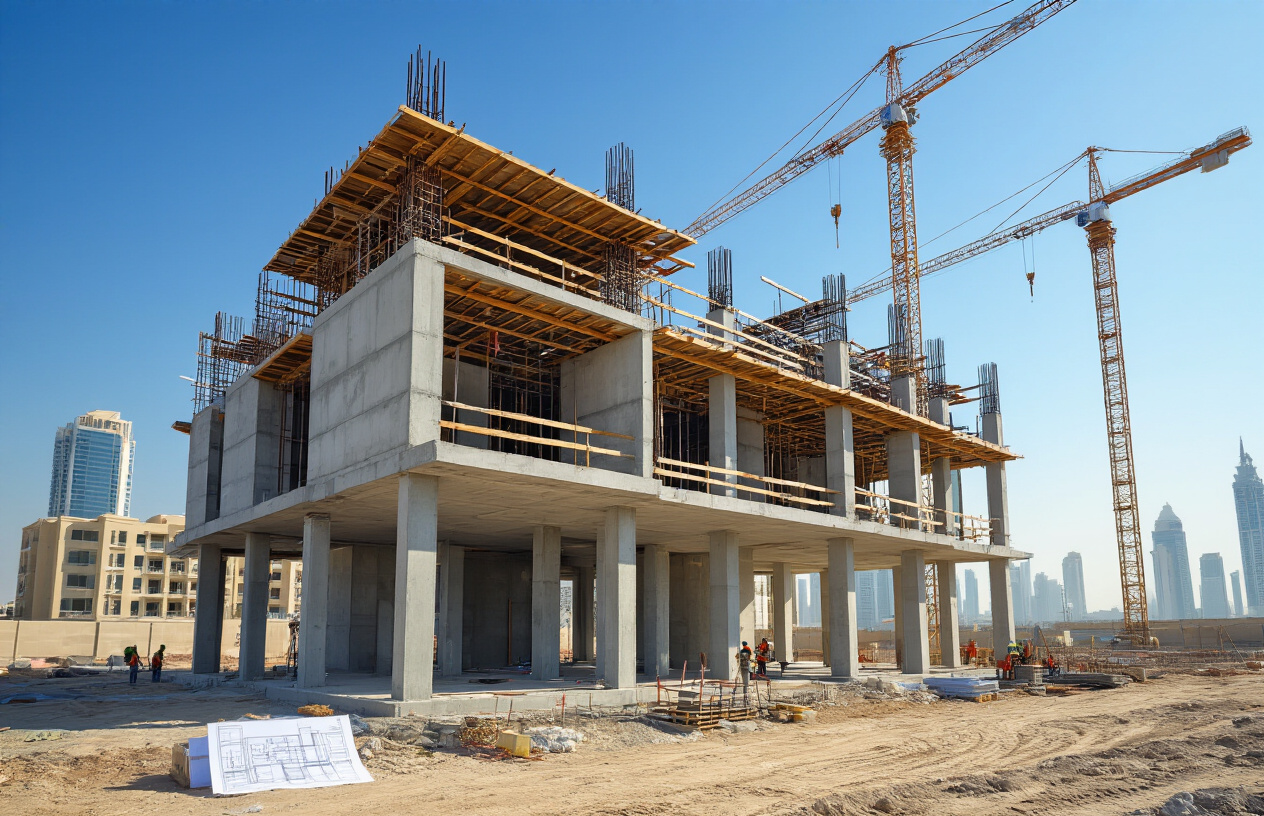
Fire Safety Regulations Protecting Your Family’s Wellbeing
UAE fire safety standards go way beyond what you might expect from building codes. The Emirates Authority for Standardization and Metrology (ESMA) enforces regulations that can literally save your life. When conducting your property inspection, you’ll want to verify that these critical safety measures are properly installed and functional.
Fire alarm systems in UAE homes must meet specific decibel requirements and include both smoke and heat detectors. Your property quality check should confirm that detectors are positioned according to Dubai Civil Defence specifications – typically one detector per 60 square meters in residential areas. Battery-powered units need monthly testing, while hardwired systems require professional annual inspections.
Emergency exit routes deserve special attention during home inspection processes. UAE regulations mandate that all sleeping areas have at least two exit paths, with windows in bedrooms large enough for emergency egress. Ground floor windows must open to at least 0.33 square meters, while upper floor windows need proper fire escape ladders or balcony access.
Fire extinguisher placement follows strict guidelines that many homeowners overlook. Class A extinguishers handle ordinary combustibles like wood and paper, while Class C units tackle electrical fires. Your property inspection should verify that extinguishers are mounted 1.5 meters from the floor and positioned within 23 meters of any potential fire source.
Electrical systems require particular scrutiny. UAE building codes demand that all electrical installations comply with BS EN standards, including proper earthing systems and residual current device (RCD) protection. Faulty wiring causes roughly 30% of residential fires in the Emirates, making this aspect of your quality check absolutely critical.
Fire-resistant materials play a huge role in UAE construction standards. Interior walls must achieve minimum fire resistance ratings, typically 60 minutes for load-bearing walls and 30 minutes for partition walls. During property inspection, check that fire-rated doors are properly installed with automatic closing mechanisms and appropriate sealing systems.
Kitchen safety regulations specifically target the highest-risk area of most homes. Range hoods must extend at least 15 centimeters beyond cooktop edges, and ventilation systems need dedicated external venting. Gas appliances require professional installation certificates and annual safety inspections to maintain compliance with Emirates Gas standards.
Insulation Requirements Reducing Energy Costs Significantly
UAE’s extreme climate makes proper insulation absolutely essential for both comfort and energy efficiency. The Dubai Municipality’s Green Building Regulations set strict thermal performance standards that directly impact your electricity bills and long-term property value.
Thermal insulation requirements vary by building zone and orientation. South-facing walls need R-values of at least 2.5 m²K/W, while north-facing surfaces require minimum R-2.0 ratings. Your property quality check should include thermal imaging assessment to identify weak spots that could be costing you thousands in cooling costs annually.
Roof insulation standards are particularly stringent due to intense solar exposure. Flat roofs must achieve R-3.5 ratings minimum, often requiring multiple insulation layers. Reflective insulation barriers help deflect radiant heat, while bulk insulation materials provide thermal resistance. Professional home inspection teams use specialized equipment to verify that roof insulation meets Emirates Authority specifications.
Wall cavity insulation presents unique challenges in UAE construction. Traditional masonry walls need continuous insulation layers to prevent thermal bridging. Modern construction methods often incorporate insulated concrete forms or structural insulated panels that exceed basic code requirements. Property inspection should verify that insulation is properly sealed around electrical outlets, plumbing penetrations, and structural connections.
Window specifications significantly impact overall thermal performance. UAE regulations now require double-glazed windows with low-emissivity coatings in most residential applications. Solar Heat Gain Coefficient (SHGC) values must stay below 0.25 for south-facing windows and 0.35 for north-facing installations. Your quality check should confirm proper window installation with appropriate sealing around frames.
Attic and crawl space insulation often gets overlooked during property inspection processes. These areas can account for up to 40% of cooling load if improperly insulated. Blown-in insulation should achieve uniform coverage without gaps or compressed areas. Vapor barriers must be correctly positioned to prevent moisture problems that could compromise insulation effectiveness.
Air sealing requirements work hand-in-hand with insulation to maximize energy efficiency. UAE building codes specify maximum air leakage rates measured through blower door testing. Common problem areas include foundation joints, attic hatches, recessed lighting fixtures, and ductwork connections. Professional property inspection includes pressure testing to identify air leaks that undermine insulation performance.
Foundation insulation deserves special attention in UAE construction. Ground contact areas need continuous insulation to prevent thermal bridging through concrete slabs. Perimeter insulation must extend below frost line depths and include moisture protection systems. Your home inspection should verify that foundation insulation is properly protected from physical damage and moisture infiltration.
Ventilation Standards Ensuring Healthy Indoor Air Quality
Indoor air quality regulations in the UAE address the unique challenges of desert climate and high humidity levels. The Dubai Municipality Health Code establishes minimum ventilation rates that prevent mold growth, reduce allergens, and maintain healthy living environments for your family.
Mechanical ventilation requirements specify exact air change rates for different room types. Bedrooms need minimum 0.5 air changes per hour, while bathrooms require 8-10 air changes hourly. Kitchen ventilation must achieve 15-20 air changes per hour during cooking periods. Your property quality check should include airflow measurements to confirm these standards are met.
Whole-house ventilation systems are increasingly common in new UAE construction. Heat recovery ventilators (HRV) and energy recovery ventilators (ERV) help maintain indoor air quality while minimizing energy costs. ERV systems are particularly beneficial in humid coastal areas, recovering both sensible and latent heat from exhaust air streams.
Natural ventilation strategies still play important roles in UAE building design. Cross-ventilation requirements ensure that habitable rooms have openings on opposite walls when possible. Window sizing must provide openable area equivalent to at least 10% of floor area. Property inspection should verify that windows operate smoothly and provide adequate ventilation when mechanical systems are offline.
Ductwork design and installation critically impacts ventilation effectiveness. UAE standards require that all ductwork be properly sealed with mastic or approved tape systems. Duct insulation must achieve minimum R-6 ratings in unconditioned spaces to prevent condensation problems. Your home inspection should include visual inspection of accessible ductwork for proper support, sealing, and insulation integrity.
Bathroom ventilation receives special attention due to high moisture loads. Exhaust fans must achieve minimum 50 CFM capacity for standard bathrooms, with higher ratings for larger spaces. Ductwork should terminate outdoors, never in attic spaces or wall cavities. Timer switches or humidity sensors help ensure adequate operation periods to remove moisture effectively.
Kitchen ventilation systems must handle both moisture and cooking odors. Range hoods require minimum 100 CFM capacity, with higher ratings for professional-style cooking equipment. Makeup air systems may be necessary for high-capacity exhaust systems to prevent negative pressure problems. Property quality check should confirm proper hood installation with adequate clearance from cooking surfaces.
Indoor air quality monitoring capabilities are becoming standard in premium UAE properties. Continuous monitoring systems track carbon dioxide levels, humidity, and volatile organic compounds. Smart ventilation controls automatically adjust operation based on occupancy and air quality conditions. Your property inspection should verify that monitoring systems are properly calibrated and connected to ventilation controls.
Filtration requirements address the unique dust and sand challenges of desert environments. HVAC systems must include minimum MERV 8 filtration, with higher ratings recommended for family members with allergies or respiratory conditions. Filter access panels need proper sealing to prevent bypass airflow. Regular filter replacement schedules are essential for maintaining system performance and indoor air quality standards.
Professional Quality Assessment Tools That Guarantee Accurate Results
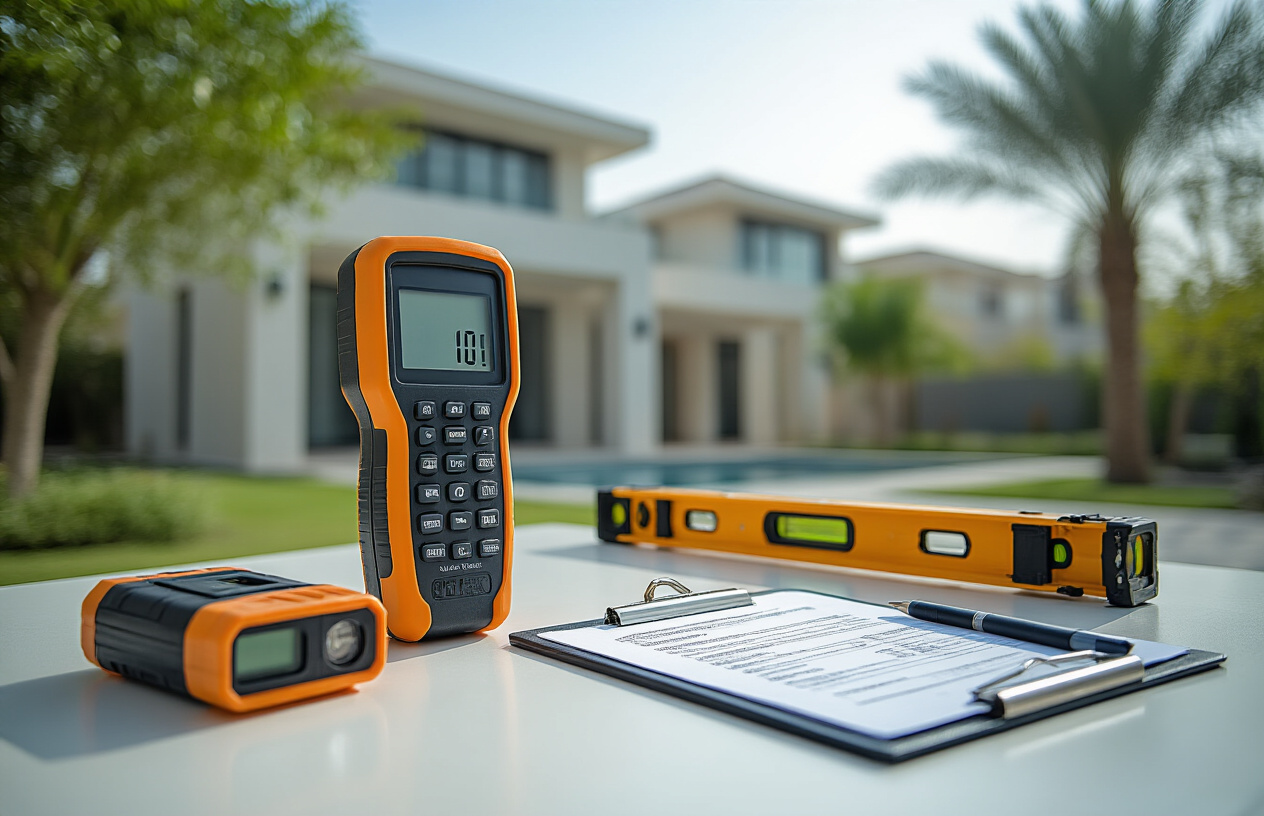
Thermal imaging technology revealing hidden defects instantly
Modern thermal imaging cameras have revolutionized how property inspectors identify structural problems that remain invisible to the naked eye. These sophisticated devices detect temperature variations across surfaces, revealing issues like insulation gaps, water leaks, electrical faults, and structural defects that could cost homeowners thousands of dollars if left unaddressed.
When conducting a property quality check in UAE homes, thermal imaging technology becomes particularly valuable due to the extreme climate conditions. The intense heat and humidity create unique challenges that traditional inspection methods often miss. Thermal cameras can detect air leaks around windows and doors where cool air escapes, driving up electricity bills dramatically. They also identify areas where insulation has deteriorated or was poorly installed during construction.
Water damage represents one of the most expensive problems in UAE properties, and thermal imaging excels at finding these issues early. Moisture behind walls, under floors, or in ceiling areas creates temperature differences that thermal cameras capture instantly. This early detection prevents mold growth, structural damage, and the need for extensive renovations later.
Key Benefits of Thermal Imaging Technology:
- Immediate detection: Problems become visible within seconds of scanning
- Non-invasive process: No need to tear apart walls or remove fixtures
- Comprehensive coverage: Entire rooms scanned in minutes
- Documentation: Images provide proof for insurance claims or warranty disputes
- Cost-effective: Prevents expensive repairs by catching issues early
Professional inspectors use high-resolution thermal cameras that provide detailed temperature readings and create comprehensive reports. These devices can detect temperature differences as small as 0.1°C, making them incredibly sensitive to even minor defects. The images clearly show problem areas in contrasting colors, making it easy for homeowners to understand exactly what needs attention.
Moisture detection equipment preventing mold growth issues
The UAE’s coastal climate creates perfect conditions for moisture problems in homes, making specialized detection equipment absolutely essential for any thorough home inspection. Professional-grade moisture meters and hygrometers provide precise readings that help identify potentially dangerous humidity levels before they lead to mold growth, wood rot, or structural damage.
Advanced moisture detection equipment goes far beyond simple humidity readings. Pin-type moisture meters penetrate materials to measure moisture content directly in wood, drywall, and concrete. Pinless meters use electromagnetic sensors to scan large areas quickly without damaging surfaces. These tools work together to create a complete picture of moisture conditions throughout the property.
Critical Areas for Moisture Detection:
- Bathrooms and kitchens: High humidity zones requiring constant monitoring
- Basements and ground floors: Areas prone to water intrusion
- Around HVAC systems: Condensation issues that damage equipment
- Window and door frames: Common entry points for moisture
- Roof areas: Leak detection preventing extensive damage
Professional moisture detection equipment includes data logging capabilities that track humidity levels over time. This feature proves particularly valuable in UAE homes where moisture levels fluctuate dramatically between air-conditioned indoor spaces and the humid outdoor environment. Some advanced systems send alerts when moisture levels exceed safe thresholds, allowing for immediate action.
Calibrated thermo-hygrometers provide accurate readings of both temperature and relative humidity, creating a complete environmental picture. These devices help identify areas where condensation might form, leading to mold growth or material degradation. The readings help determine whether mechanical ventilation systems work effectively or need adjustment.
Modern moisture detection equipment also includes infrared thermometers that work alongside other tools to identify areas where moisture might accumulate. Cold spots often indicate areas where condensation forms regularly, while warm spots might suggest air leaks or insulation problems that contribute to moisture issues.
Foundation stability testing securing long-term property value
Foundation problems represent the most serious structural issues that can affect any property, making comprehensive stability testing a non-negotiable part of any property inspection. In the UAE, unique soil conditions, including expansive clay and sandy soils, create specific challenges that require specialized testing equipment and expertise.
Ground-penetrating radar (GPR) technology allows inspectors to see below the surface without excavation. This equipment sends radio waves into the ground, creating detailed images of soil conditions, underground utilities, and potential voids that might affect foundation stability. GPR proves particularly valuable in detecting sinkholes or unstable soil conditions that aren’t visible from the surface.
Essential Foundation Testing Equipment:
- Digital levels: Measure slopes and settlement with incredible precision
- Crack monitoring systems: Track movement over time
- Soil density meters: Assess ground stability around foundations
- Moisture meters: Detect water intrusion that weakens foundations
- Structural load testing equipment: Verify weight-bearing capacity
Electronic crack monitoring systems use sensors placed across existing cracks to measure movement over time. These systems provide objective data about whether cracks are actively growing or have stabilized. The data helps determine whether immediate repairs are necessary or if the situation requires ongoing monitoring.
Professional-grade laser levels create precise measurements across foundation surfaces, detecting settlement or movement as small as a few millimeters. This precision proves crucial in identifying problems before they become visible as cracks in walls or doors that won’t close properly.
Soil testing equipment analyzes the ground conditions around foundations, measuring density, moisture content, and composition. In the UAE, where soil conditions can vary dramatically even within a single property, this information helps predict future stability issues and determine appropriate maintenance strategies.
Advanced testing includes dynamic penetration testing that measures soil resistance at various depths. This data helps assess whether the foundation extends deep enough into stable soil layers and whether the original construction met appropriate standards for local conditions.
Energy efficiency audits cutting utility expenses permanently
Professional energy efficiency audits use sophisticated equipment to identify exactly where homes waste energy and money. In the UAE’s extreme climate, where cooling costs can represent 70% of total utility expenses, these audits provide homeowners with specific, actionable solutions that deliver immediate savings and long-term value.
Blower door testing equipment creates controlled pressure differences that reveal air leaks throughout the home. The system uses powerful fans to either pressurize or depressurize the building while sensitive instruments measure air exchange rates. This testing identifies specific locations where conditioned air escapes and hot outdoor air enters the home.
Professional Energy Audit Equipment:
- Infrared cameras: Visualize heat loss and air leaks
- Blower door fans: Measure overall building tightness
- Digital manometers: Assess pressure differences and airflow
- Power meters: Analyze electrical consumption patterns
- Combustible gas detectors: Ensure safety while improving efficiency
Sophisticated power monitoring equipment tracks electrical usage patterns throughout the home, identifying appliances and systems that consume excessive energy. These devices can monitor individual circuits, providing detailed information about which areas of the home use the most electricity and when peak usage occurs.
Smart thermostats with data logging capabilities provide detailed information about HVAC system performance and energy usage patterns. This equipment helps identify whether air conditioning systems operate efficiently or require maintenance, repairs, or upgrades to reduce energy consumption.
Professional-grade light meters assess lighting efficiency throughout the home, determining whether current fixtures provide adequate illumination while minimizing energy consumption. The equipment measures both quantity and quality of light, helping homeowners make informed decisions about lighting upgrades.
Advanced energy audits include duct leakage testing using specialized equipment that measures air loss in HVAC distribution systems. In UAE homes, where extensive ductwork distributes cooled air throughout large spaces, even small leaks can result in significant energy waste and increased utility bills.
Window film transmission meters test the effectiveness of existing window treatments and help evaluate potential upgrades. These devices measure how much heat, light, and UV radiation pass through windows, providing data needed to calculate potential energy savings from window improvements.
The comprehensive data from professional energy audits creates detailed reports showing exactly how much money each recommended improvement will save over time. This information helps homeowners prioritize upgrades based on return on investment, ensuring they get the maximum benefit from their improvement budget.
Common Property Defects in UAE Homes and Prevention Strategies
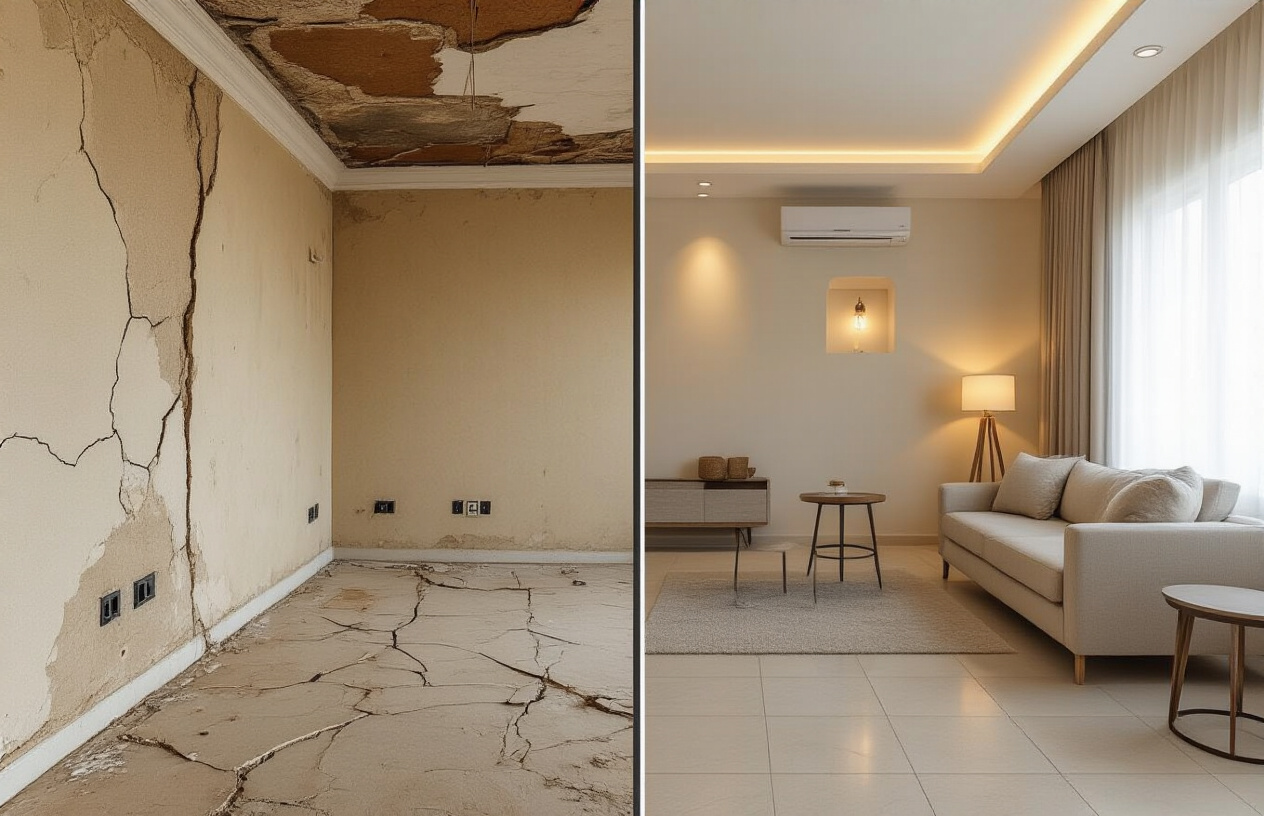
Sand Infiltration Problems Affecting Building Longevity
The UAE’s desert environment brings unique challenges that property owners often discover too late. Sand infiltration ranks among the most persistent and destructive issues facing homes across the Emirates, silently compromising structural integrity while driving up maintenance costs year after year.
Sand particles penetrate building systems through the smallest gaps – around windows, doors, ventilation systems, and even microscopic cracks in exterior walls. When conducting a comprehensive property inspection in the UAE, understanding sand infiltration patterns becomes essential for protecting your investment. The fine desert sand, composed primarily of quartz particles, acts like an abrasive compound that wears down seals, clogs filtration systems, and creates pathways for moisture intrusion.
Building envelopes face constant assault from wind-driven sand particles traveling at high velocities. These particles accumulate in window tracks, compromise weatherstripping, and gradually erode protective coatings on exterior surfaces. Professional home inspection protocols must include detailed examination of all potential entry points, particularly around fenestration assemblies and building joints.
The economic impact of sand infiltration extends beyond immediate cleaning concerns. HVAC systems suffer accelerated wear when sand particles circulate through ductwork, leading to premature equipment failure and dramatically increased energy consumption. Air filtration systems require frequent replacement, often monthly during peak sand season, adding thousands of dirhams to annual maintenance budgets.
Preventive strategies begin with proper building design and material selection. High-quality weatherstripping rated for extreme desert conditions provides the first line of defense. Positive pressure ventilation systems help prevent sand infiltration by maintaining higher interior air pressure relative to outdoor conditions. Regular seal inspection and replacement schedules prevent small problems from becoming major structural issues.
Window and door assemblies require specialized attention in UAE properties. Standard residential weatherstripping fails rapidly under constant sand exposure. Marine-grade or aerospace-grade sealing materials offer superior longevity, though initial costs run higher than conventional options. The investment pays dividends through reduced maintenance frequency and improved indoor air quality.
Landscaping choices dramatically influence sand infiltration rates. Strategic placement of vegetation and hardscaping elements creates wind barriers that redirect sand-laden air currents away from building exteriors. Native plant species adapted to desert conditions require minimal water while providing effective sand control. Avoiding expansive lawn areas near building perimeters reduces irrigation-related moisture issues that can exacerbate sand infiltration problems.
Professional property quality check procedures must account for seasonal variations in sand exposure. Spring months typically bring the highest sand activity levels, making this period ideal for comprehensive infiltration assessments. Inspection protocols should document current sand accumulation patterns, evaluate existing protective measures, and identify vulnerable areas requiring immediate attention.
Cooling System Failures During Extreme Summer Temperatures
UAE summers push mechanical cooling systems beyond their design limits, creating failure conditions that can render properties uninhabitable within hours. Temperature extremes regularly exceeding 45°C combined with humidity levels above 90% create operating conditions that challenge even the most robust HVAC equipment. Understanding these failure modes protects property values while ensuring occupant safety during critical summer months.
Compressor failure represents the most common and costly cooling system breakdown in UAE homes. When outdoor temperatures soar above 48°C, standard residential compressors operate well beyond their efficient range, leading to overheating and eventual mechanical failure. The refrigeration cycle becomes increasingly inefficient as temperature differentials decrease, forcing compressors to run continuously without adequate cooling recovery periods.
Electrical system overloads compound mechanical stress during peak cooling demand periods. UAE’s electrical grid experiences significant strain during summer months, leading to voltage fluctuations and power quality issues that damage sensitive electronic components. Surge protection becomes critical for preserving expensive cooling equipment investments.
Ductwork design inadequacies become apparent only during extreme heat events. Under-sized ductwork creates excessive static pressure that reduces system efficiency and accelerates equipment wear. Poor insulation around ductwork running through unconditioned spaces allows massive heat gain that overwhelms cooling capacity. Professional home inspection services must evaluate entire ductwork systems, not just terminal equipment.
Refrigerant leaks develop more frequently under extreme operating conditions. High-pressure differentials stress connection points, gaskets, and coil assemblies. Detecting refrigerant leaks requires specialized equipment and trained technicians capable of working safely with pressurized systems. Small leaks compound rapidly during peak cooling season, leading to complete system failure when outdoor temperatures peak.
Preventive maintenance becomes absolutely critical for surviving UAE summers. Monthly filter changes during cooling season prevent airflow restrictions that force compressors to work harder. Annual professional maintenance should include refrigerant level verification, electrical connection inspection, and comprehensive system cleaning. These services cost significantly less than emergency repairs during peak summer demand periods.
Backup cooling strategies provide insurance against primary system failures. Portable air conditioning units offer temporary relief while permanent repairs proceed. Battery backup systems maintain basic ventilation during power outages that commonly occur during extreme weather events. Smart home systems can monitor equipment performance and alert owners to developing problems before complete failures occur.
Energy efficiency improvements reduce system stress while controlling operating costs. High-efficiency air conditioning units designed for extreme climate operation provide better reliability than standard residential equipment. Variable speed compressors adjust output based on actual cooling demand rather than cycling on and off continuously. These technologies extend equipment life while improving comfort levels.
Building envelope improvements support mechanical cooling systems by reducing heat gain. Reflective roofing materials can reduce attic temperatures by 15-20°C compared to standard materials. High-performance window films block solar heat gain while maintaining natural lighting. Proper attic ventilation prevents heat buildup that increases cooling loads throughout the structure.
Water Leakage Issues Causing Structural Deterioration
Water intrusion represents the most destructive force affecting UAE homes, capable of causing catastrophic structural damage within surprisingly short timeframes. Desert climate conditions create unique water damage patterns that differ significantly from temperate climate experiences. Understanding these mechanisms protects property investments while preventing health hazards associated with water-damaged building materials.
Plumbing system failures occur more frequently in UAE properties due to extreme temperature variations and water quality issues. Thermal expansion and contraction cycles stress pipe joints and fittings beyond their design limits. Temperature swings of 30-40°C between day and night throughout winter months create continuous stress cycles that eventually cause connection failures.
Water quality throughout the UAE contains high mineral concentrations that accelerate corrosion in metal plumbing components. Desalinated water, while safe for consumption, lacks natural corrosion inhibitors found in traditional groundwater sources. Calcium and magnesium deposits build up inside pipes and fixtures, creating pressure points that lead to catastrophic failures.
Concealed piping runs behind walls and under floors make leak detection challenging until significant damage occurs. By the time water stains appear on interior surfaces, structural damage has often progressed to costly repair stages. Moisture meters and thermal imaging cameras help identify hidden leaks before visible damage appears, making these tools essential for comprehensive property quality check procedures.
Bathroom waterproofing failures create some of the most expensive repair scenarios in residential properties. Shower enclosures and bathroom floors require continuous waterproof membranes that maintain integrity despite building movement and temperature variations. Poor installation techniques or material failures allow water penetration into structural elements, leading to rot, mold growth, and potential structural collapse.
Roof waterproofing presents unique challenges in UAE climate conditions. Flat roof designs common throughout the Emirates require specialized waterproofing systems capable of withstanding extreme temperature variations and occasional intense rainfall events. Membrane materials must resist UV degradation while maintaining flexibility during thermal cycling.
Traditional waterproofing materials often fail prematurely under UAE conditions. Standard asphalt-based membranes become brittle and crack during extreme heat exposure. Synthetic membrane systems offer superior longevity but require specialized installation techniques and higher initial investment costs. Professional installation becomes critical for achieving expected service life from premium waterproofing systems.
Foundation waterproofing requires different approaches in UAE properties compared to traditional construction practices. High groundwater tables in coastal areas create hydrostatic pressure against foundation walls. Expansive clay soils common throughout the UAE change volume dramatically with moisture content variations, creating foundation movement that can compromise waterproof barriers.
Preventive strategies focus on early detection and proactive maintenance rather than reactive repairs. Annual plumbing system inspections identify developing problems before catastrophic failures occur. Water pressure monitoring systems alert property owners to unusual consumption patterns that often indicate concealed leaks. These systems pay for themselves many times over by preventing major water damage events.
Smart home technology offers sophisticated leak detection capabilities that provide early warning of developing problems. Wireless sensors placed near water fixtures and appliances can detect moisture accumulation and alert property owners through smartphone applications. Automatic water shut-off systems can prevent catastrophic damage by stopping water flow when leaks are detected.
Professional property inspection services must include comprehensive water intrusion assessments using specialized detection equipment. Moisture meters reveal hidden water accumulation within wall and floor assemblies. Infrared cameras identify temperature variations that indicate water intrusion patterns. These tools help identify problems during early stages when repairs remain manageable and affordable.
Regular maintenance schedules prevent many common water leakage issues from developing into major problems. Annual roof inspections identify membrane deterioration before leaks develop. Plumbing system pressure testing reveals weak points before they fail catastrophically. Sealant replacement around windows and doors prevents water intrusion during occasional heavy rainfall events that can overwhelm compromised building envelopes.
Legal Documentation Requirements Ensuring Smooth Property Transactions
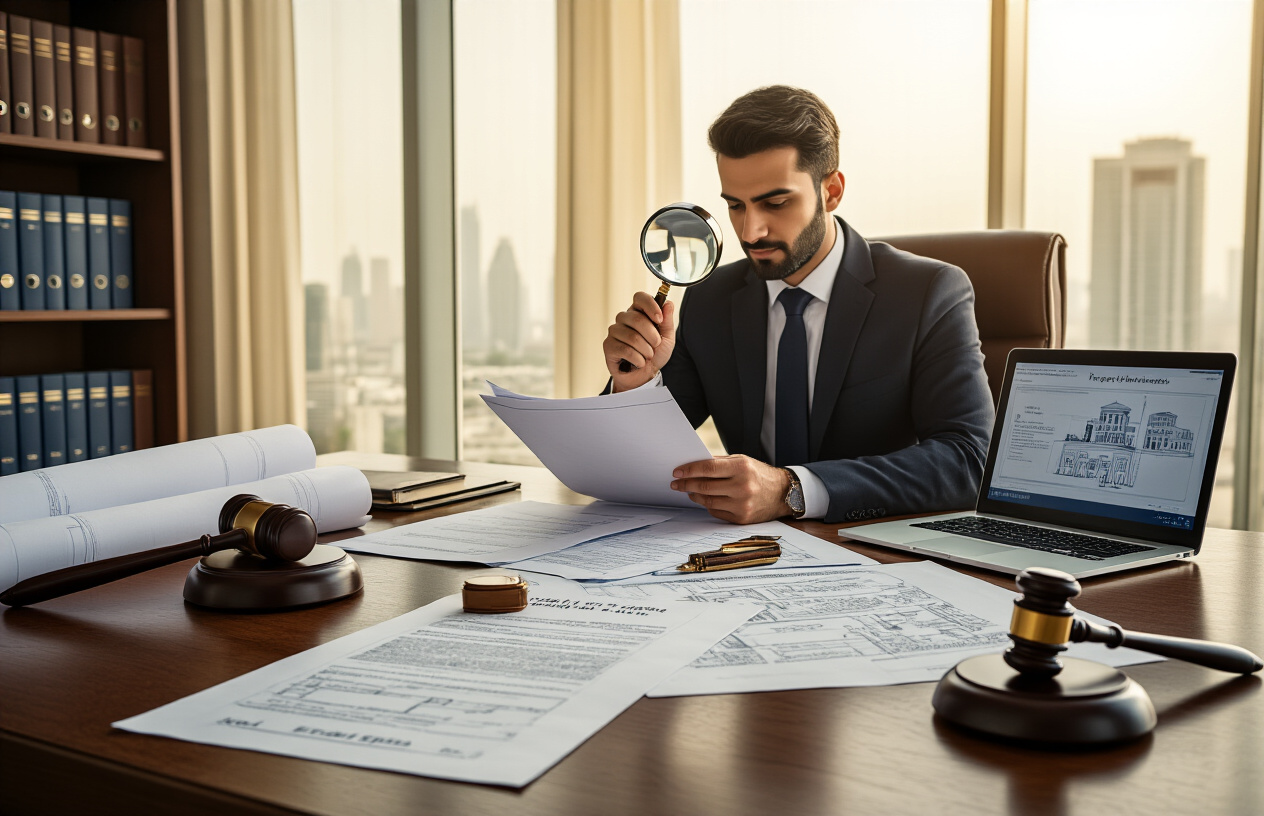
Municipality Approval Certificates Validating Construction Standards
Getting your hands on the right municipality approval certificates isn’t just paperwork – it’s your guarantee that the property you’re buying actually meets UAE construction standards. Think of these certificates as your property’s birth certificate and report card rolled into one.
The Dubai Municipality, Abu Dhabi City Municipality, and other emirate authorities issue several critical certificates that you absolutely need to verify during your property quality check. The most important one is the Completion Certificate, which confirms that construction has been finished according to approved plans. Without this document, you’re essentially buying a property that might not be legally habitable.
The Building Permit serves as the foundation document, showing that the original construction was authorized and planned according to local building codes. This permit includes detailed architectural and engineering drawings that inspectors used to verify compliance during construction. When conducting your home inspection, cross-reference the actual property features with these approved plans. Any major deviations could signal unauthorized modifications that might affect structural integrity or property value.
Fire Safety Certificate approval is another non-negotiable document, especially in high-rise buildings common throughout UAE homes. This certificate confirms that the building meets fire safety standards, including proper escape routes, fire-resistant materials, and functioning safety systems. The UAE has particularly strict fire safety regulations following several high-profile incidents, making this certificate extremely valuable for your peace of mind.
The Occupancy Permit essentially gives you the green light to actually live in the property. Municipal authorities issue this certificate only after thorough inspections confirm that all systems work properly and the building is safe for habitation. Properties without valid occupancy permits face legal complications and potential fines.
Environmental clearance certificates have become increasingly important as UAE authorities focus on sustainable development. These documents verify that the property meets environmental standards and doesn’t pose health risks to residents. For properties near industrial areas or those built on previously developed land, environmental clearance becomes especially critical.
Municipal approval certificates also include specific technical inspections covering structural integrity, electrical systems, and plumbing installations. These technical clearances provide detailed verification that core building systems meet UAE construction standards. During your property inspection, request copies of all technical inspection reports, not just the summary certificates.
Utility Connection Certificates Confirming Service Availability
Nobody wants to move into their dream home only to discover the electricity doesn’t work or the water pressure barely trickles. Utility connection certificates provide concrete proof that all essential services are properly connected and functioning.
The Dubai Electricity and Water Authority (DEWA), Abu Dhabi Water and Electricity Authority (ADWEA), and other emirate utility providers issue specific certificates confirming active service connections. These certificates detail the property’s utility account numbers, connection capacities, and service classifications. More importantly, they confirm that all utility bills are current and no outstanding debts exist that could interrupt service.
Electrical connection certificates specify the power supply capacity and confirm that electrical installations meet UAE electrical codes. These documents include details about meter installations, main distribution panels, and safety switches. During your property quality check, verify that the electrical capacity matches your expected usage needs. Many UAE homes feature high-capacity electrical systems to support air conditioning and modern appliances, but older properties might need upgrades.
Water and sewerage connection certificates confirm both fresh water supply and wastewater disposal systems are properly connected to municipal networks. In some UAE developments, properties rely on private water treatment systems or shared infrastructure. These certificates clarify exactly which systems serve your property and who maintains them.
Telecommunications connection certificates verify that phone, internet, and cable TV services are available and properly connected. With remote work becoming more common, reliable internet connectivity isn’t just convenient – it’s essential. These certificates often include details about available service speeds and provider options.
Gas connection certificates apply to properties with natural gas supplies for cooking or heating. While not universal in UAE homes, properties with gas connections require proper certification to ensure safety compliance. These certificates detail gas meter locations, pipeline specifications, and safety shut-off procedures.
District cooling certificates have become increasingly common in newer UAE developments. District cooling systems provide centralized air conditioning to multiple buildings, offering energy efficiency benefits. These certificates confirm your property’s connection to district cooling networks and specify cooling capacity allocations.
Smart home system certificates are emerging as newer developments incorporate advanced home automation technologies. These certificates verify that smart home infrastructure meets technical standards and integrates properly with utility systems.
Developer Warranty Documents Protecting Against Construction Defects
Developer warranties serve as your insurance policy against construction defects and material failures that might not become apparent until months or years after purchase. Understanding these warranty documents protects your investment and gives you clear recourse if problems arise.
Structural warranty coverage typically extends for ten years and covers major building components including foundations, load-bearing walls, roof structures, and essential building systems. This warranty represents the developer’s confidence in construction quality and provides financial protection against expensive structural repairs. When reviewing structural warranty documents, pay attention to coverage exclusions and the specific procedures for filing claims.
Finishing warranty coverage usually lasts one to two years and covers items like flooring, paint, fixtures, and interior installations. While shorter than structural warranties, finishing warranties protect against defects in materials and workmanship that affect your daily living experience. Document any finishing defects immediately after taking possession, as warranty claims become more difficult to prove over time.
Waterproofing warranties deserve special attention in UAE homes due to the challenging climate conditions. These warranties typically cover bathroom waterproofing, balcony sealing, and exterior wall protection against water infiltration. Given the potential for significant damage from water leaks, waterproofing warranties often include specific maintenance requirements that homeowners must follow to maintain coverage.
Mechanical systems warranties cover HVAC equipment, elevators, and other building machinery. These warranties usually range from one to five years depending on the equipment type and manufacturer. For property inspection purposes, verify that all mechanical systems are properly commissioned and warranty registration is complete.
Swimming pool and landscaping warranties apply to properties with these amenities. Pool warranties typically cover structural integrity, equipment functionality, and finishing materials. Landscaping warranties might include plant survival guarantees and irrigation system performance.
Developer warranty documents should clearly specify claim procedures, response timeframes, and repair standards. The best warranties include expedited procedures for urgent repairs that affect habitability or safety. Some developers offer extended warranty programs for additional fees, which might be worthwhile for expensive properties or those with complex systems.
Third-party warranty backing provides additional security by involving independent warranty companies that can fulfill warranty obligations even if the original developer faces financial difficulties. This backing becomes particularly valuable for properties from smaller or newer development companies.
Insurance Coverage Verification Securing Financial Protection
Insurance verification isn’t just about ticking boxes – it’s about making sure you’re actually protected when things go wrong. The right insurance coverage protects your property investment and provides peace of mind throughout your ownership experience.
Building insurance coverage protects the physical structure of your property against fire, natural disasters, and other covered perils. In the UAE, building insurance typically includes coverage for structural damage from sandstorms, flooding, and extreme weather events. For apartment owners, building insurance is usually arranged by the property management company and included in service charges. However, villa owners need individual building insurance policies.
Contents insurance covers your personal belongings inside the property, including furniture, electronics, and personal items. This coverage becomes especially important for furnished properties or homes with valuable contents. Contents insurance policies often include coverage for temporary accommodation if your home becomes uninhabitable due to covered damage.
Public liability insurance protects you against claims from visitors who might be injured on your property. This coverage is particularly important for villa owners with pools, gardens, or other amenities where accidents might occur. Some UAE emirates require minimum public liability coverage as part of property ownership requirements.
Mortgage protection insurance provides loan payment coverage if you become unable to make mortgage payments due to unemployment, disability, or death. While not always required, mortgage protection insurance offers valuable financial security for property owners with significant loan obligations.
Rental income protection insurance applies to investment properties and provides coverage if rental income is interrupted due to property damage or tenant default. This insurance helps maintain mortgage payments and property expenses even when rental income stops temporarily.
Professional indemnity insurance becomes relevant if you discover that professionals involved in your property purchase or inspection provided inadequate services. This coverage might help recover costs associated with poor legal advice, inadequate property inspections, or other professional negligence.
Title insurance protects against legal challenges to your property ownership. While less common in the UAE than in some other countries, title insurance can provide valuable protection against disputes over property boundaries, ownership history, or legal title issues.
Insurance verification should include checking policy coverage limits, deductibles, and exclusions. Many property owners underestimate the replacement cost of their property and end up with insufficient coverage. Regular insurance reviews help ensure coverage keeps pace with property values and renovation improvements.
Claims history verification provides insight into the property’s past insurance claims and might reveal recurring problems or hidden defects. Properties with extensive claims histories might face higher insurance premiums or coverage restrictions. During your property quality check, request disclosure of any insurance claims filed for the property within the past five years.

Smart property buyers in the UAE know that a thorough quality check can save them thousands of dirhams and years of headaches. From understanding building code compliance to spotting common defects before they become expensive problems, taking the time to properly inspect your potential home is one of the best investments you’ll ever make. Professional assessment tools and qualified inspectors can uncover issues that might not be visible to the untrained eye, giving you the confidence to move forward or the leverage to negotiate a better deal.
Don’t let excitement about a new property cloud your judgment when it comes to due diligence. Make sure all legal documentation is in order and consider hiring a professional inspector who knows UAE building standards inside and out. Your future self will thank you for doing the homework now rather than discovering costly surprises after you’ve already signed on the dotted line. Remember, a quality home inspection isn’t just about finding problems – it’s about making an informed decision that protects both your investment and your family’s safety.







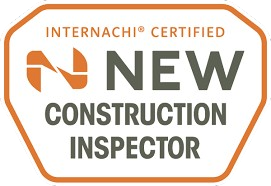









Inspectors is a trusted property inspection service in the UAE, delivering detailed reports, expert evaluations, and over 12 years of industry experience to help you make confident real estate decisions.
Services
Get in Touch
- Phone: +971 50 774 0231
- Email: info@inspectors.ae
- Address: Building Number 9 - M02 - Hafiz St - Al Nahyan - E25 - Abu Dhabi
2025 © All Rights Reserved by Inspectors.ae
